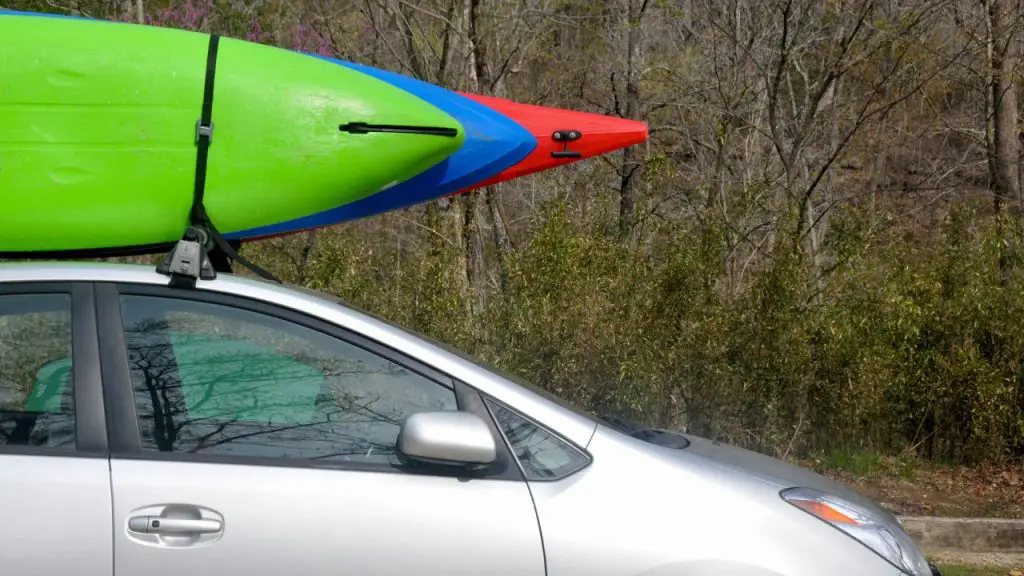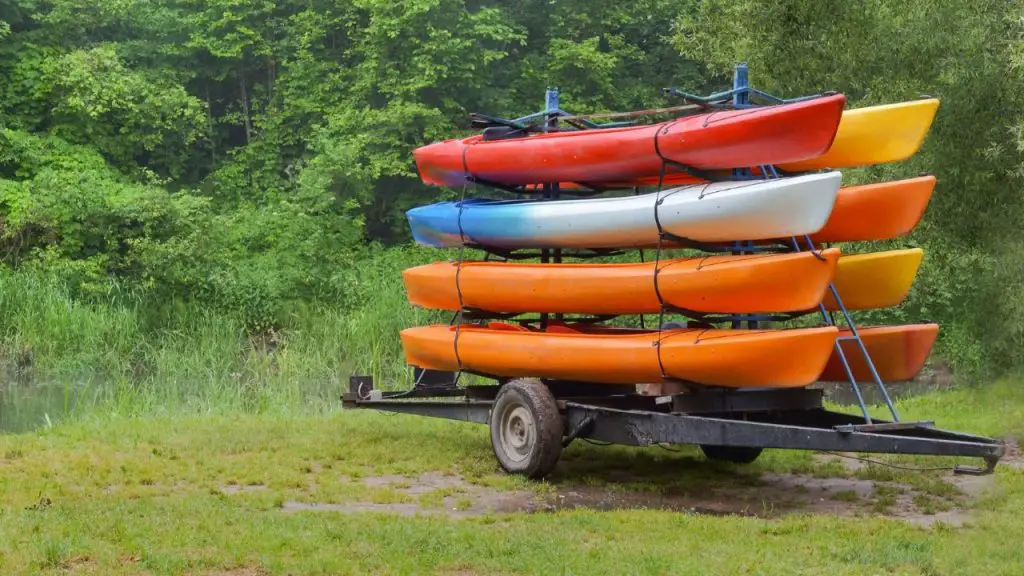Transporting your kayak to your favorite spot can be a hassle, particularly if you are doing it for the first time. And things can get challenging if you need to transport multiple kayaks at once. How do you transport 3 kayaks safely?
As kayakers gain experience over time, they find methods of transportation that work for them. For newbies, however, it takes a little bit of time and effort to get the hang of it. If you are a novice kayaker wondering how to transport multiple kayaks, keep reading.
In this post, we are going to discuss some ways to transport 3 kayaks safely and smartly. Hopefully, these tips will make the process easier for you.
Table of Contents
6 Ways To Transport 3 Kayaks
The most convenient way to transport 3 kayaks is to secure them to your vehicle’s roof rack. If your vehicle has no roof rack, you can use a kayak rack, a utility trailer or a pickup truck to transport the kayaks.
Other alternatives include combining a roof rack and truck bed, and combining foam blocks and pool noodles.

Use Roof Rack
If you have a relatively large vehicle with a roof rack, you can load your kayaks on the roof rack and secure them to it. What you basically have to do is to stack one kayak on another. As you load the first kayak on the roof rack, secure the vessel tightly and then stack the second one on top of the first.
Rather than stacking the third one on top of the first two, lay it horizontally parallel to the other two and secure the three together. Loading a kayak on your vehicle’s roof rack is easier if you do it with a buddy. Unless your kayaks are small, you are likely to find it pretty hard to load them by yourself.
Use a Kayak Rack
Using a three-tier kayak rack is one of the most convenient ways to transport your kayaks. Place the rack on your pickup truck and use a strap to secure the rack to the vehicle, in order to prevent the rack from moving it forward and backwards. A 15-foot strap is enough to secure the rack tightly.
Once you have adjusted the rack, secure the kayaks into the rack, one by one. The rack comes with two additional pipes intended to be placed between the rack scupper and the upper pipe to prevent the kayaks from moving.
AA-Racks Model X31 800Ibs Capacity Extendable Steel Pick-Up Truck
Use a Pickup Truck
Loading your kayaks on a pickup truck is easier than loading them on other types of vehicles, in part because the truck bed is not at a high elevation. Even if you have pretty large kayaks, you can load them by yourself. And once you have done so, the only thing you have to do is to secure them with straps so that the kayaks stay there at highway speeds.
You need two straps to secure your kayaks. Place straps over the top to hold the vessels down, flat into the bed. Then attach the straps through the loops. Attaching them will be easier if your truck has D-ring brackets.
Pro tip: Instead of using ratchet straps, consider using cam straps, which are easier to pull on and tighten.
Combine Roof Rack and Truck Bed
If the roof of your vehicle is not wide enough, you can mount one kayak on the roof and the other two on the truck bed. The one that goes on the roof can be secured to the roof rack. For the other two, you can install J racks on the truck bed and then mount the vessels on the racks.
Of course, there are not any roof racks on the truck bed, but you can attach the J racks to the bars as you would to the roof racks. Once you have done so, just load the kayaks on the J racks and secure the vessels with cam straps.
YAKIMA, JayLow Rooftop Mounted Kayak Rack for Vehiclesa
Combine Foam Blocks and Pool Noodles
First, put foam blocks on your vehicle’s roof rack. Then load the first kayak on the rack and secure the vessel with straps to make the foundation solid. Before you stack the second kayak on top of the first, place two pool noodles in between the two vessels. Secure the second kayak on top, with its own set of straps.
Do not stack the third one on top of the two, because that would be too high, and there would be too much wind resistance when you drive the vehicle. Place the kayak on the main roof rack, horizontal to the pile.
Also, put foam blocks in between the rack and the kayak. Then use a super strong strap to tie the whole pile down to the roof rack.
attwood 11438-7 Universal Rack-Free Car-Top Kayak Carrier Kit
Utility Trailer
A small vehicle is not convenient for transporting large kayaks. In such a case, you may need to use a utility trailer. Consider hiring a local fabricator who can build a trailer for transporting your kayaks.
Make sure the trailer has tie down attachment options and eyeballs so that you can conveniently tie the kayaks down. Attach foam to the trailer to make sure your kayaks do not get scratched or dinged up. Get the trailer painted to match the color of your vehicle.
Opt for this option only if you have to transport multiple huge kayaks. In most cases, your vehicle will be enough for getting the job done.
Multi-Sport Multi-Rack Kayak Trailer
Tips to Transport Multiple Kayaks
Transporting multiple kayaks may seem a daunting task, but you will find the process a lot easier if you have a strategic approach. Here are some tips you will find useful:
- The way you transport your kayak largely depends on their weight and size. If you have small kayaks, you can easily load them on the roof of your vehicle and secure them to the roof rack. If they are huge and heavy, you may need to build a custom utility trailer to transport them.
- Before you load your kayaks on the roof of your vehicle, know how much weight the roof is designed to support.
- Do not use straps that are torn or worn out.
- The kayaks must be tied down and secured properly. Use multiple straps, preferably cam straps, to tie down your kayaks in the front, back, and side to side.

- Before you hit the road, double-check the straps and make sure they are secured.
- Rather than hooking the straps onto the plastic parts of your car, attach them to D-ring brackets. Plastic parts may break off.
- Consider attaching a red flag to your kayak to the rear of your vehicle or kayak to inform other drivers of the overhang. Check if there are specific road safety rules in your state that may apply to the transportation of water vessels.
- Consider getting the help of a buddy when loading and securing the kayaks, especially if you are doing it for the first time.
- If you think transporting kayaks is too much of a hassle for you, just skip everything, go to the spot, and rent kayaks.
2 Pieces 18 x 18 Inch Hook Safety Warning Flag
FAQs
How do you carry 3 kayaks on a car?
Secure the kayaks to your vehicle’s roof rack. Alternatively, you can use a three-tier kayak rack. If your kayaks are large and heavy, you can use a utility trailer or pickup truck to transport the kayaks.
Can you fit 3 kayaks on top of a car?
If you have a small car, its roof may not be wide enough to accommodate 3 kayaks. However, by attaching two J racks to the roof rack, you can transport 3 kayaks. Just make sure that the J racks are spaced apart so that you can place the third kayak in between the other two. Secure each kayak individually, with straps.
Can you get 3 kayaks on a roof rack?
It depends on the width of your vehicle’s roof. If you have a small vehicle, you may not be able to get 3 kayaks on the roof. In such a case, you can use a utility trailer or a pickup truck to get the job done.
How do you transport 3 kayaks in a truck bed?
The easiest way to transport 3 kayaks in a truck bed is to use a 3-tier kayak rack. Place the kayaks in the rack and secure them with straps.
Conclusion
Transporting multiple kayaks requires a little bit of strategy. If you have small kayaks and a large vehicle, the process is pretty straightforward: just load the kayaks on the roof and secure them to the roof rack.
But if your vehicle’s roof is not spacious enough, adopt any of the methods we have discussed. It all comes down to finding a strategy that works for you. We hope now you are better prepared to take actionable steps.






